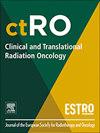检查选择性盆腔放疗在诊断为高风险和极高风险非转移性前列腺癌患者中的作用
IF 2.7
3区 医学
Q3 ONCOLOGY
引用次数: 0
摘要
在淋巴结阴性、非转移性高危(HR)和极高危(VHR)前列腺癌的治疗中,选择性骨盆照射的必要性存在争议。根据我们的内部治疗方案,对于70岁以上的HR和VHR患者或由于其毒性而一般健康状况不佳的患者,通常省略选择性骨盆照射。目的回顾性比较选择性全盆腔放疗(WPRT)与单纯前列腺放疗(PORT)对HR和VHR前列腺癌患者的治疗效果。材料与方法本研究纳入434例接受明确放疗的患者,203例接受PORT治疗(HR: 127, VHR: 76), 231例接受WPRT治疗(HR: 113, VHR: 118)。患者还接受了2-3年的雄激素剥夺。PORT组和WPRT组患者的平均年龄分别为73.9±4.3岁和66.4±5.4岁。使用逆倾向评分加权法创建均匀的WPRT和PORT治疗组,这些治疗组在T分期、PSA和Gleason评分方面是平衡的,但不受年龄的影响。HR和VHR亚组的生存结果取决于他们是否接受WPRT或PORT。采用Kaplan - Meier方法和Cox回归分析比较生化- (BRFS)、局部- (LRFS)和区域无复发生存(RRFS)、远端无转移- (DMFS)、无病- (DFS)、无故障- (FFS)和总生存(OS)。结果中位随访时间为76个月(3 ~ 134个月)。在VHR亚组中,BRFS患者接受WPRT和PORT的5年结果显示显著优势(82.2%对73%;p = 0.028), DMFS组(87.5% vs. 73.6%;p = 0.025),在DFS中(86.1% vs. 70.5%;p = 0.012), FFS组(82.3% vs. 68.9%;P = 0.005)。操作系统(92.8% vs. 81.8%;p = 0.056)显示出有利于WPRT组的趋势。WPRT与PORT在LRFS中的差异无统计学意义(95.8% vs 96.4%;p = 0.763)和RRFS (95.8% vs. 89.9%;p = 0.099)。相反,在人力资源组,没有观察到显著的生存差异之间WPRT与端口组:BRFS 93.0%与93.3% (p = 0.978),探测器99.0%与100% (p = 0.120), RRFS 98.2%与95.1% (p = 0.813),出现时间93.5%和95.5% (p = 0.793), DFS 91.7%与92.9% (p = 0.691), FFS 89.5%与90.9% (p = 0.853),操作系统91.0%比87.7% (p = 0.407)。结论根据我们的回顾性资料,选择性骨盆照射可以在HR患者,特别是70岁以上的患者中被忽略。对于VHR患者,即使是老年患者亚组,也应考虑选择性骨盆照射。本文章由计算机程序翻译,如有差异,请以英文原文为准。
Examining the role of elective pelvic radiotherapy in patients Diagnosed with high- and very High-Risk Non-Metastatic prostate cancer
Introduction
In the treatment of node-negative, non-metastatic high-risk (HR) and very high-risk (VHR) prostate cancer, the necessity of elective pelvic irradiation is controversial. According to our in-house treatment protocol − elective pelvic irradiation is generally omitted for HR and VHR patients over the age of 70 or those in poor general health due to its toxicity.
Objective
To retrospectively examine the outcome for HR and VHR prostate cancer patients treated with elective whole pelvic radiotherapy (WPRT) versus prostate-only radiotherapy (PORT).
Materials and Methods
The study included 434 patients treated with definitive radiotherapy, 203 patients received PORT (HR: 127, VHR: 76) and 231 WPRT (HR: 113, VHR: 118) with a boost to the prostate. Patients also received 2–3 years of androgen deprivation. Patients’ average age who received PORT vs. WPRT was 73.9 ± 4.3 years vs. 66.4 ± 5.4 years respectively. An inverse propensity score weighting method was utilized to create homogeneous WPRT and PORT treatment groups that are balanced for T stage, PSA, and Gleason score, but not for age. The survival outcomes for HR and VHR subgroups were examined depending on whether they received WPRT or PORT. Biochemical- (BRFS), local- (LRFS) and regional relapse-free survival (RRFS), distant metastasis-free- (DMFS), disease-free- (DFS), failure-free- (FFS), and overall survival (OS) were compared using the Kaplan −Meier method and Cox regression analysis.
Results
The median follow-up time was 76 months (3–134 months). In the VHR subgroup five-year outcomes showed a significant advantage for patients receiving WPRT vs. PORT in BRFS (82.2 % vs. 73 %; p = 0.028), in DMFS (87.5 % vs. 73.6 %; p = 0.025), in DFS (86.1 % vs. 70.5 %; p = 0.012), and in FFS (82.3 % vs. 68.9 %; p = 0.005), respectively. The OS (92.8 % vs. 81.8 %; p = 0.056) showed a trend favoring the WPRT group. There was no significant difference between WPRT vs. PORT in LRFS (95.8 % vs. 96.4 %; p = 0.763) and RRFS (95.8 % vs. 89.9 %; p = 0.099). On the contrary, in the HR group, no significant survival differences were observed between WPRT vs. PORT groups: BRFS 93.0 % vs. 93.3 % (p = 0.978), LRFS 99.0 % vs. 100 % (p = 0.120), RRFS 98.2 % vs. 95.1 % (p = 0.813), DMFS 93.5 % vs. 95.5 % (p = 0.793), DFS 91.7 % vs. 92.9 % (p = 0.691), FFS 89.5 % vs. 90.9 % (p = 0.853), OS 91.0 % vs. 87.7 % (p = 0.407).
Conclusion
Based on our retrospective data elective pelvic irradiation can be omitted in HR patients, especially over the age of 70. For VHR patients, elective pelvic irradiation should be considered even for the subgroup of elderly patients.
求助全文
通过发布文献求助,成功后即可免费获取论文全文。
去求助
来源期刊

Clinical and Translational Radiation Oncology
Medicine-Radiology, Nuclear Medicine and Imaging
CiteScore
5.30
自引率
3.20%
发文量
114
审稿时长
40 days
 求助内容:
求助内容: 应助结果提醒方式:
应助结果提醒方式:


